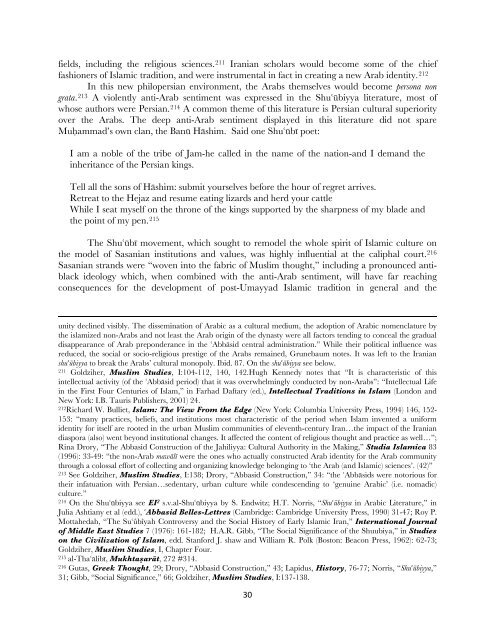“Anyone who says that the Prophet is black should be killed”: The ...
“Anyone who says that the Prophet is black should be killed”: The ...
“Anyone who says that the Prophet is black should be killed”: The ...
You also want an ePaper? Increase the reach of your titles
YUMPU automatically turns print PDFs into web optimized ePapers that Google loves.
fields, including <strong>the</strong> religious sciences. 211 Iranian scholars would <strong>be</strong>come some of <strong>the</strong> chief<br />
fashioners of Islamic tradition, and were instrumental in fact in creating a new Arab identity. 212<br />
In th<strong>is</strong> new philopersian environment, <strong>the</strong> Arabs <strong>the</strong>mselves would <strong>be</strong>come persona non<br />
grata. 213 A violently anti-Arab sentiment was expressed in <strong>the</strong> Shu#åbiyya literature, most of<br />
<strong>who</strong>se authors were Persian. 214 A common <strong>the</strong>me of th<strong>is</strong> literature <strong>is</strong> Persian cultural superiority<br />
over <strong>the</strong> Arabs. <strong>The</strong> deep anti-Arab sentiment d<strong>is</strong>played in th<strong>is</strong> literature did not spare<br />
MuÈammad’s own clan, <strong>the</strong> Banå H§shim. Said one Shu#åbÊ poet:<br />
I am a noble of <strong>the</strong> tri<strong>be</strong> of Jam-he called in <strong>the</strong> name of <strong>the</strong> nation-and I demand <strong>the</strong><br />
inheritance of <strong>the</strong> Persian kings.<br />
Tell all <strong>the</strong> sons of H§shim: submit yourselves <strong>be</strong>fore <strong>the</strong> hour of regret arrives.<br />
Retreat to <strong>the</strong> Hejaz and resume eating lizards and herd your cattle<br />
While I seat myself on <strong>the</strong> throne of <strong>the</strong> kings supported by <strong>the</strong> sharpness of my blade and<br />
<strong>the</strong> point of my pen. 215<br />
<strong>The</strong> Shu#åbÊ movement, which sought to remodel <strong>the</strong> <strong>who</strong>le spirit of Islamic culture on<br />
<strong>the</strong> model of Sasanian institutions and values, was highly influential at <strong>the</strong> caliphal court. 216<br />
Sasanian strands were “woven into <strong>the</strong> fabric of Muslim thought,” including a pronounced anti<strong>black</strong><br />
ideology which, when combined with <strong>the</strong> anti-Arab sentiment, will have far reaching<br />
consequences for <strong>the</strong> development of post-Umayyad Islamic tradition in general and <strong>the</strong><br />
unity declined v<strong>is</strong>ibly. <strong>The</strong> d<strong>is</strong>semination of Arabic as a cultural medium, <strong>the</strong> adoption of Arabic nomenclature by<br />
<strong>the</strong> <strong>is</strong>lamized non-Arabs and not least <strong>the</strong> Arab origin of <strong>the</strong> dynasty were all factors tending to conceal <strong>the</strong> gradual<br />
d<strong>is</strong>appearance of Arab preponderance in <strong>the</strong> #Abb§sid central admin<strong>is</strong>tration.” While <strong>the</strong>ir political influence was<br />
reduced, <strong>the</strong> social or socio-religious prestige of <strong>the</strong> Arabs remained, Grunebaum notes. It was left to <strong>the</strong> Iranian<br />
shu#åbiyya to break <strong>the</strong> Arabs’ cultural monopoly. Ibid. 87. On <strong>the</strong> shu#åbiyya see <strong>be</strong>low.<br />
211 Goldziher, Muslim Studies, I:104-112, 140, 142.Hugh Kennedy notes <strong>that</strong> “It <strong>is</strong> character<strong>is</strong>tic of th<strong>is</strong><br />
intellectual activity (of <strong>the</strong> #Abb§sid period) <strong>that</strong> it was overwhelmingly conducted by non-Arabs”: “Intellectual Life<br />
in <strong>the</strong> First Four Centuries of Islam,” in Farhad Daftary (ed.), Intellectual Traditions in Islam (London and<br />
New York: I.B. Taur<strong>is</strong> Publ<strong>is</strong>hers, 2001) 24.<br />
212 Richard W. Bulliet, Islam: <strong>The</strong> View From <strong>the</strong> Edge (New York: Columbia University Press, 1994) 146, 152-<br />
153: “many practices, <strong>be</strong>liefs, and institutions most character<strong>is</strong>tic of <strong>the</strong> period when Islam invented a uniform<br />
identity for itself are rooted in <strong>the</strong> urban Muslim communities of eleventh-century Iran…<strong>the</strong> impact of <strong>the</strong> Iranian<br />
diaspora (also) went <strong>be</strong>yond institutional changes. It affected <strong>the</strong> content of religious thought and practice as well…”;<br />
Rina Drory, “<strong>The</strong> Abbasid Construction of <strong>the</strong> Jahiliyya: Cultural Authority in <strong>the</strong> Making,” Studia Islamica 83<br />
(1996): 33-49: “<strong>the</strong> non-Arab maw§lÊ were <strong>the</strong> ones <strong>who</strong> actually constructed Arab identity for <strong>the</strong> Arab community<br />
through a colossal effort of collecting and organizing knowledge <strong>be</strong>longing to ‘<strong>the</strong> Arab (and Islamic) sciences’. (42)”<br />
213 See Goldziher, Muslim Studies, I:138; Drory, “Abbasid Construction,” 34: “<strong>the</strong> #Abb§sids were notorious for<br />
<strong>the</strong>ir infatuation with Persian…sedentary, urban culture while condescending to ‘genuine Arabic’ (i.e. nomadic)<br />
culture.”<br />
214 On <strong>the</strong> Shu#åbiyya see EI 2 s.v.al-Shu#åbiyya by S. Endwitz; H.T. Norr<strong>is</strong>, “Shu#åbiyya in Arabic Literature,” in<br />
Julia Ashtiany et al (edd.), #Abbasid Belles-Lettres (Cambridge: Cambridge University Press, 1990) 31-47; Roy P.<br />
Mottahedah, “<strong>The</strong> Su#ûbîyah Controversy and <strong>the</strong> Social H<strong>is</strong>tory of Early Islamic Iran,” International Journal<br />
of Middle East Studies 7 (1976): 161-182; H.A.R. Gibb, “<strong>The</strong> Social Significance of <strong>the</strong> Shuubiya,” in Studies<br />
on <strong>the</strong> Civilization of Islam, edd. Stanford J. shaw and William R. Polk (Boston: Beacon Press, 1962): 62-73;<br />
Goldziher, Muslim Studies, I, Chapter Four.<br />
215 al-Tha#§libÊ, Mukhtaßar§t, 272 #314.<br />
216 Gutas, Greek Thought, 29; Drory, “Abbasid Construction,” 43; Lapidus, H<strong>is</strong>tory, 76-77; Norr<strong>is</strong>, “Shu#åbiyya,”<br />
31; Gibb, “Social Significance,” 66; Goldziher, Muslim Studies, I:137-138.<br />
30
















